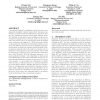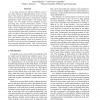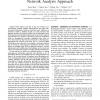134
Voted
EDBT
2012
ACM
13 years 3 months ago
2012
ACM
Conventional research on similarity search focuses on measuring the similarity between objects with the same type. However, in many real-world applications, we need to measure the...
189
Voted
SDM
2012
SIAM
13 years 3 months ago
2012
SIAM
Given the ubiquity of time series data, the data mining community has spent significant time investigating the best time series similarity measure to use for various tasks and dom...
170
Voted
CVPR
2012
IEEE
13 years 3 months ago
2012
IEEE
A new data structure for efficient similarity search in very large datasets of high-dimensional vectors is introduced. This structure called the inverted multi-index generalizes ...
130
click to vote
CVPR
2012
IEEE
13 years 3 months ago
2012
IEEE
Many binary code encoding schemes based on hashing have been actively studied recently, since they can provide efficient similarity search, especially nearest neighbor search, an...
139
Voted
KDD
2012
ACM
13 years 3 months ago
2012
ACM
Most time series data mining algorithms use similarity search as a core subroutine, and thus the time taken for similarity search is the bottleneck for virtually all time series d...
127
Voted
KDD
2012
ACM
13 years 3 months ago
2012
ACM
In recent years, both hashing-based similarity search and multimodal similarity search have aroused much research interest in the data mining and other communities. While hashing-...
145
Voted
KDD
2012
ACM
13 years 3 months ago
2012
ACM
Heterogeneous information networks that contain multiple types of objects and links are ubiquitous in the real world, such as bibliographic networks, cyber-physical networks, and ...
137
Voted
TOG
2012
13 years 3 months ago
2012
Large collections of 3D models from the same object class (e.g., chairs, cars, animals) are now commonly available via many public repositories, but exploring the range of shape v...
129
click to vote
ICDE
2012
IEEE
13 years 3 months ago
2012
IEEE
Abstract—Most objects and data in the real world are interconnected, forming complex, heterogeneous but often semistructured information networks. However, many database research...
117
Voted
SIGMOD
2011
ACM
14 years 3 months ago
2011
ACM
Aggregate similarity search, a.k.a. aggregate nearest neighbor (Ann) query, finds many useful applications in spatial and multimedia databases. Given a group Q of M query objects...




